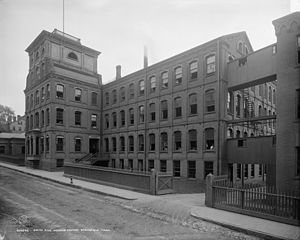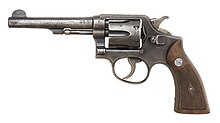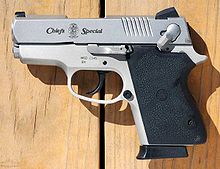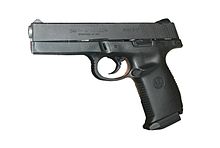Alright, now I know you might think I will run out of historical data at the rate I have been going, as I've covered the semi-auto pistol's beginnings in the 191 and covered a overview of all revolvers. So a couple rifle types and shotgun types then I'm done, right?
Wrong! Every building must have a strong foundation. I'm not sure if anyone is reading these posts, but if they are and if they are new to gun types the basics must be covered first.
Since handguns are the most prevalent I covered the two categories that they fall into. Now I will start to give histories of some of the major gun companies. After that we can move into specific hand guns and move into long guns and shotguns.
I do know that there are other handgun types, like derringers, but they are not in the majority. They will be covered in time though. Remember, there are probably other history items about these guns and feel free to post them under the correct weapon history topic if you want to share it. Most of the information I give here is pulled from the actual company sights or online encyclopedia's like the Wiki.
For this addition of Weapon History I introduce to you the company of Smith & Wesson.

Smith & Wesson factory in Springfield, Massachusetts, circa 1908.
Smith & Wesson (NASDAQ: SWHC) (S&W) is the largest manufacturer of handguns in the United States. The corporate headquarters is in Springfield, Massachusetts. Founded in 1852, Smith & Wesson's pistols and revolvers have become standard issue to police and armed forces throughout the world. They are also used by sport shooters and have been featured in numerous Hollywood movies, particularly Clint Eastwood's Dirty Harry. Smith & Wesson has been known for the many types of ammunition it has introduced over the years, and many cartridges bear the company's name.

S & W K .22.
Beginning: In 1852 partners Horace Smith and Daniel B. Wesson formed a company to produce a lever-action pistol nicknamed the Volcanic pistol. The company became known as the "Volcanic Repeating Arms Company"; financial difficulties caused it to come into the majority ownership of investor Oliver Winchester. Previously, in the late 1840s, Daniel Wesson's brother Edwin, of Hartford, Massachusetts, had manufactured revolvers under the name of Wesson & Leavitt. After Edwin Wesson's death, that firm continued under the supervision of Thomas Warner.
In 1856 the partners left the Volcanic Company to begin a new company and to manufacture a newly-designed revolver-and-cartridge combination which would become known as the Smith & Wesson Model 1. The success of Model 1 was due to a combination of new innovations, the bored through cylinder and the self-contained metallic cartridge. A man by the name of Rollin White had patented his invention, patent (#12,648, 3 April 1855) on bored-through revolver cylinders for metallic cartridge use. Smith & Wesson negotiated with Rollin White for assignment of the patent, agreeing to pay him a small royalty on every pistol sold. In return, White agreed to pay any legal fees associated with the defense of his patent against any infringements. For more than one decade Smith & Wesson was the sole manufacturer of this technological improvement. However, the success did not come without a fight. Other manufacturers quickly developed unique metallic cartridges and cylinders designed to circumvent White's patent. White took these manufactures to court, where he eventually won in 1862, however full implementation of the ruling did not take effect until 1865. The timing of the founding of this new company proved quite opportune for the partners, since the onset of the American Civil War five years later produced a great demand for Smith & Wesson's products, specifically the Smith & Wesson Model 2.
In 1867, Smith & Wesson began a global sales campaign that introduced the company's revolvers and ammunition to new markets, such as Russia, and established the company as one of the world's premier makers of firearms. The Smith & Wesson Model 3, eventually became known as the "Russian Model" and was a favorite of US Lawman, Wyatt Earp. The US Army adopted the Model 3 as the "Schofield" and used it throughout the Indian Wars of the West.
In 1964 the company passed from Wesson family control, and subsequently several conglomerates took control of it.
Between 1987 and 2001 Smith & Wesson was owned by the British engineering company Tomkins PLC.
Agreement of 2000: In March 2000 Smith & Wesson signed an agreement with the Clinton Administration in order to avoid lawsuits. The company agreed to numerous safety and design standards, as well as limits on the sale and distribution of their products. Gun clubs and gun rights groups responded to this agreement by initiating large-scale boycotts of Smith & Wesson by refusing to buy their new products and flooding the firearms market with used S&W guns. After a 40% sales slide, the sales impact from the boycotts lead Smith and Wesson to suspend manufacturing at two plants. The success of the boycott lead to a Federal Trade Commission anti-trust investigation being initiated under the Clinton administration,targeting gun dealers and gun rights groups, which was subsequently dropped in 2003. This agreement signed by Tomkins PLC ended with the sale of Smith and Wesson to the Saf-T-Hammer Corporation. The new company (Smith and Wesson Holding Corporation), which publicly renounced the agreement, was received positively by the firearms community.
Acquisition by Saf-T-Hammer: On 11 May 2001, Saf-T-Hammer Corporation acquired Smith & Wesson Corp. from Tomkins PLC for US$15 million, a fraction of the US$112 million originally paid by Tomkins. Saf-T-Hammer assumed US$30 million in debt, bringing the total purchase price to US$45 million.[11][12] Saf-T-Hammer, a manufacturer of gun locks and other firearms safety products, purchased the company with the intention of incorporating its line of security products into all Smith & Wesson firearms in compliance with the 2000 agreement.
The acquisition of Smith & Wesson was chiefly brokered by Saf-T-Hammer President Bob Scott, who had left Smith & Wesson in 1999 because of a disagreement with Tomkins’ policies. After the purchase, Scott became the president of Smith & Wesson to guide the 157-year-old company back to its former standing in the market.
On 15 February 2002, the name of the newly formed entity was changed to Smith & Wesson Holding Corporation.
Ammunition types introduced by Smith & Wesson: .22 Short
.32 S&W—sometimes called .32 Short
.32 S&W Long—sometimes called .32 New Colt Police
.32-44 S&W, defined as .32 Caliber (true .32 caliber measures .323", sole use in Model 3 Revolver to 1898.
.38 S&W—sometimes called .38 Colt New Police and the 38/200 in England.
.38-44 S&W There are two distinct loads with this designation. The first was intended for use in model 3 revolvers up to 1898. The second was a predecessor to the .357 Magnum. Using the latter load in a pre-1898 gun could cause serious injury.
.38 S&W Special
.357 S&W Magnum
.40 S&W
.41 Magnum—While Remington Arms developed the ammunition, Smith & Wesson made the first revolvers to chamber the cartridge.
.44 S&W Special
.44 Remington Magnum
.45 S&W Schofield
.460 S&W Magnum
.500 S&W Magnum
Notable revolvers: 
Smith & Wesson Volcanic, caliber .31, between 1854 and 1855

Smith & Wesson Model 1, caliber .22

Smith & Wesson Model 1 Second Issue, .22 rimfire Post 1857

Smith & Wesson Army No 2, made 1863, caliber .32 Rimfire

Smith & Wesson Model 3, Cal. .44, between 1874 and 1878

Smith & Wesson Model 3, Cal. .44, between 1881 and 1923

Smith & Wesson .38 Special Model 1899 Military and Police Hand Ejector

Smith & Wesson Model 10 cal. 38

Smith and Wesson .44 Hand Ejector 1st Model "New Century", chambered for .455, with English proof marks, likely used by English forces in WWI

Smith & Wesson M1917 cal. 45
Smith & Wesson has produced revolvers over the years in several standard frame sizes. "M refers to the small early Ladysmith frame, I to the small .32 frame, J to the small .38 frame, K to the medium .38 frame, L to medium large, and N to the largest .44 Magnum type frame"
J-Frame (small) Models Smith & Wesson Model 36—known as the "Chiefs Special"; first J-frame (1950), 5-shot revolver
Smith & Wesson Model 37—known as the "Chiefs Special Airweight";
Smith & Wesson Model 60—first regular production all stainless steel revolver (1965); the stainless Chief's Special
Smith & Wesson Model 340PD—first revolver made of scandium alloy, very light, possibly the final evolution of the classic J-frame Chief's Special introduced over 60 years earlier, weighs 12 ounces (340 g).
Smith & Wesson Lemon Squeezer—The "lemon squeezer," also known as Model 40, Model 42 and 38 Safety
Smith & Wesson Centennial—standard and "Airweight" (Models 40, 42, 442, 640, 642) (at one time available in 9x19mm caliber as the Model 940)
Smith & Wesson Chief's Special—standard and "Airweight" (Models 36, 37, 60, 637)
Smith & Wesson Bodyguard—standard and "Airweight" (Models 38, 380, 49, 438, 638, 649)
Smith & Wesson Ladysmith
K-Frame (medium) Models Smith & Wesson Model 10—.38 Special. Previously the ".38 Military & Police"
Smith & Wesson Model 11—.38 S&W. Previously the ".38 Regular Military & Police"
Smith & Wesson Model 12—.38 Special. "Airweight" (alloy frame) version of the Model 10.
Smith & Wesson Model 13—.357 Magnum version of the Model 10.
Smith & Wesson Model 14—.38 Special. Previously the "K-38 Masterpiece"
Smith & Wesson Model 15—.38 Special. Previously the "38 Combat Masterpiece"
Smith & Wesson Model 16—.32 Caliber. Previously the "K-32 Masterpiece"
Smith & Wesson Model 17—.22 Caliber. Previously the "K-22 Masterpiece"
Smith & Wesson Model 18—.22 Caliber. Previously the "22 Combat Masterpiece"
Smith & Wesson Model 19—.357 Magnum. Previously the "Combat Magnum"; first lightweight .357 Magnum, built at the request of Bill Jordan
Smith & Wesson Model 53—blued steel .22 Magnum, built for .22 Remington Jet Center fire Magnum ammunition[
Smith & Wesson Model 64—.38 Special. Stainless steel version of the Model 10.
Smith & Wesson Model 65—.357 Magnum. Stainless steel version of the Model 13
Smith & Wesson Model 66—.357 Magnum. Stainless steel version of the Model 19
Smith & Wesson Model 67—.38 Special. Stainless steel version of the Model 15
Smith & Wesson Model 68—.38 Special version of the Model 66 (half-lug) 6" barrel
Smith & Wesson Model 617—.22 Caliber. Full-lug, Stainless steel, 10-shot version of the Model 17
L-Frame (medium-large) Models Smith & Wesson Model 386—alloy
Smith & Wesson Model 586—blued steel
Smith & Wesson Model 686—stainless steel
Smith & Wesson Model 619—7-shot .357 Magnum, no full underlug, fixed sights.
Smith & Wesson Model 620—7-shot .357 Magnum, no full underlug, adjustable sights.
Smith & Wesson Model 646—stainless steel .40 S&W, adjustable sights

Two Smith & Wesson models 686
M-Frame (extra small old) Models Smith & Wesson 38 Double Action—nickeled steel .38 S&W
N-Frame (large) Models .44 Hand Ejector First Model "New Century"—first N-frame, introduced in 1908. The first chambering of .44 S&W Special.
Model 1917—first revolver chambered for .45 ACP
Smith & Wesson Model 22—.45 ACP/.45 Auto Rim; also called the M1950 Military; Base for the 2nd issue Thunder Ranch Revolver; This was the evolution of the M1917 revolver
Smith & Wesson Model 25—similar to the Model 29, but chambered for the .45 ACP/.45 Auto Rim and later, the .45 Colt cartridge. The best known, and most common, variants of this revolver are the Model 25-2 (.45 ACP) and Model 25-5 (.45 Colt).
Smith & Wesson Model 27—first .357 Magnum; usually a custom or limited-run revolver, with a deep blue lustre
Smith & Wesson Model 28—"Highway Patrolman" .357 Magnum; fewer frills than the Model 27, same performance; marketed to police for its reduced price and equal performance.
Smith & Wesson Model 29—first .44 Magnum by s&w, made famous by its appearance in the film Dirty Harry
Smith & Wesson Model 57—first .41 Magnum; initiated and sponsored by Elmer Keith and others, top end premier model identical in features, fit, and finish to .44 Magnum Model 29.
Smith & Wesson Model 58—.41 Magnum; 4-inch barrel with fixed sights; marketed as basic, entry-level police duty revolver offering greater power than .38/.357 revolvers when using a reduced power .41 Magnum police load.
Smith & Wesson Model 610
Smith & Wesson Model 625—used by Jerry Miculek in .45 ACP to set the world record for 12 rounds (with one reload) on target in 2.99 seconds

Smith & Wesson Model 29s .44 Remington Magnum, 4- and 8⅜-inch barrels
X-Frame
Smith & Wesson Model 500
Smith & Wesson Model 460XVR
Notable semi-automatic pistols Semi-automatic pistols: In 1953 the US Army was looking for a pistol to replace the Colt 1911A1. In order to obtain a bid from the US Government, Smith & Wesson began working on a design similar to the German Walther P-38. A year later the Army dropped its search and Smith & Wesson introduced its pistol to the civilian shooting market as the Model 39.
The Model 39 would come to be known as a first generation pistol. Since the Model 39 debuted, Smith & Wesson has continuously developed this design into its third generation pistols now on the market. The first generation models use a 2 digit model number, the second generation use 3 digits, and third generation models use 4 digits.
Smith & Wesson Model 1913—The first center fire S&W semi-automatic pistol began in 1913. This pistol was also known as the model 35 which was produced from 1913 to 1922.
Smith & Wesson Model 39—first U.S.-designed double action pistol in 9 mm Luger (or Parabellum)
Smith & Wesson Model 41
Smith & Wesson Model 52
Smith & Wesson Model 4506
Smith & Wesson Model 439—updated model 39
Smith & Wesson Model 459—S&W's entry into the US Army's XM9 program
Smith & Wesson Model 469
Smith & Wesson Model 59—S&W's first high-capacity double-action pistol in 9 mm Parabellum.
Smith & Wesson Model 5906
Smith & Wesson Model 61—Debuting in 1970, the pocket 'Escort' was a tiny automatic .22LR pistol, designed to be cheap and easily concealable. It was available in blued or nickel-plated with black or white plastic grips. Production stopped in 1973.
Smith & Wesson Model 908
Smith & Wesson Model 909
Smith & Wesson Model 910
Smith & Wesson Model 915
Smith & Wesson Model 1006—stainless steel 10mm Auto
Smith & Wesson Model 1026 with a frame-mounted decocker
Smith & Wesson Model 4006

.45 Semi-auto Chief's Special
Sigma series: Smith & Wesson introduced the Sigma series of recoil-operated, locked-breech semi-auto pistols in 1994 with the Sigma SW40F, followed by the Sigma SW9F 9 mm, which included a 17 shot magazine. Glock initiated a patent infringement lawsuit against Smith & Wesson. The latter paid an undisclosed amount to settle the case and for the right to continue producing models in the Sigma line. The gun frame is manufactured from polymer, while the slide and barrel use either stainless steel or carbon steel. In 1996, Smith & Wesson updated the Sigma by adding a compact model by shortening the barrel (from 4-1/2 to 4 inches) and again in 1999, modified the series by changing the grip by adding checkering and adding an integral accessory rail for lights and laser targeting devices.
SW9 in 9 mm Luger Parabellum
SW40 in .40 S&W
SW357V in .357 sig
SW380 in .380 ACP

A Sigma pistol
SW99 Series: S&W reached an agreement with Walther to produce variations of the P99 line of pistols. Branded as the SW99, the pistol is available in several calibers, including 9 mm, .40 S&W, and .45 ACP, and in both full size and compact variations. Under the terms of the agreement, Walther produced the frames, and Smith and Wesson produced the slide and barrel. The pistol has several cosmetic differences from the original Walther design and strongly resembles a hybrid between the P99 and the Sigma series.
M&P Series: In 2005, Smith & Wesson debuted a new polymer-frame pistol intended for the law enforcement market. Dubbed the M&P (for Military and Police), its name was meant to evoke S&W's history as the firearm of choice for law enforcement agencies through its previous lineup of M&P revolvers. The M&P is a completely new design with no parts interchangeable with any other pistol including the Sigma. The new design not only looks completely different than the Sigma but feels completely different with 3 different back straps supplied with each M&P. Many of the ergonomic study elements that had been incorporated into the Sigma and the SW99 were brought over to the M&P. The improved trigger weight and feel, and unique takedown method (not requiring a dry pull of the trigger) were meant to set the M&P apart from both the Sigma and the popular Glock pistols.
The M&P is available in 9x19 mm Para, .40 S&W, and .357 SIG. A .45 ACP model was released in early 2007, after making its debut at the SHOT Show. In addition, compact versions are available in 9x19 mm Para, .40 S&W, .357 SIG, and .45 ACP.

Smith & Wesson M&P pistol.
SW1911 Series: In 2003, Smith & Wesson introduced their variation of the classic M1911 .45 ACP semi-automatic handgun, the SW1911. This firearm retains the M1911's well known dimensions, operation, and feel, while adding a variety of modern touches. Updates to the design include serration at the front of the slide for easier operation and disassembly, a high "beaver-tail" grip safety, external extractor, lighter weight hammer and trigger, as well as updated internal safeties to prevent accidental discharges if dropped. S&W 1911s are available with black finished carbon steel slides and frames or bead blasted stainless slides and frames. They are available with aluminum frames alloyed with scandium in either natural or black finishes. These updates have resulted in a firearm that is true to the M1911 design, with additions that would normally be considered "custom", with a price similar to equivalent designs from other manufacturers.
Smith & Wesson's Performance Center produces the top of the line hand fitted competition version knowns as the PC 1911. While most 1911s run around 38 to 39 ounces (1,100 to 1,100 g), the PC 1911 is heavier, at approximately 41 ounces (1,200 g). The full-length guide rod adds some weight, and so does the add-on magazine well.

A basic version of Smith & Wesson's SW1911 with user-installed Pachmayr grips.
READ MORE AT:http://en.wikipedia.org/wiki/Smith_%26_Wesson
 Pages: 1
Pages: 1
 Pages: 1
Pages: 1
 Pages: 1
Pages: 1
 Pages: 1
Pages: 1